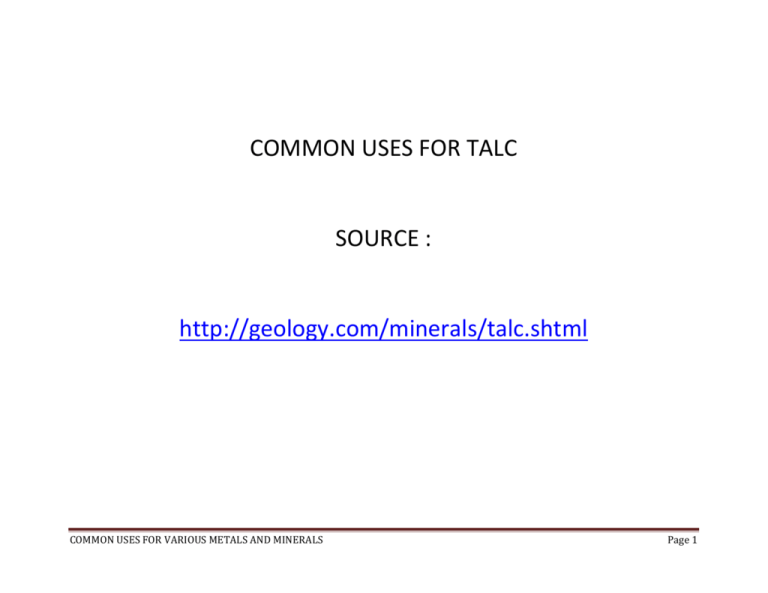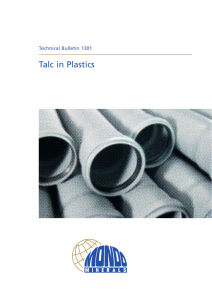COMMON USES FOR TALC SOURCE : http://geology.com/minerals
advertisement

COMMON USES FOR TALC SOURCE : http://geology.com/minerals/talc.shtml COMMONUSESFORVARIOUSMETALSANDMINERALS Page1 Metal Talc Uses Talc in Plastics In 2011, about 26% of the talc consumed in the United States was used in the manufacturing of plastics. It is mainly used as a filler. The platy shape of talc particles can increase the stiffness of products such as polypropylene, vinyl, polyethylene, nylon and polyester. It can also increase the heat resistance of these products and reduce shrinkage. Where the plastic is extruded in the manufacturing process talc's very low hardness produces less abrasion on equipment than harder mineral fillers. Talc in Ceramics In the United States in 2011, about 17% of the talc consumed was used in the manufacturing of ceramics products such as bathroom fixtures, ceramic tile, pottery and dinnerware. When used as a filler in ceramics, talc can improve the firing characteristics of the greenware and the strength of the finished product. COMMONUSESFORVARIOUSMETALSANDMINERALS Page2 Metal Talc Uses Talc in Paint Most paints are suspensions of mineral particles in a liquid. The liquid portion of the paint facilitates application but after the liquid evaporates the mineral particles remain on the wall. Talc is used as an extender and filler in paints. The platy shape of talc particles improves the suspension of solids in the can and helps the liquid paint adhere to a wall without sagging. Powdered talc is a very bright white color. This makes talc an excellent filler in paint because it simultaneously serves to whiten and brighten the paint. Talc's low hardness is valued because it causes less abrasion damage on spray nozzles and other equipment when paint is applied. In 2011, about 16% of the talc consumed in the United States was used to make paint. Talc in Paper Most papers are made from a pulp of organic fibers. This pulp is made from wood, rags and other organic materials. Finely‐ground mineral matter is added to the pulp to serve as a filler. When the pulp is rolled into thin sheets the mineral matter fills spaces between the pulp fibers, resulting in a paper with a much smoother writing surface. Talc as a mineral fillers can improve the opacity, brightness and whiteness of the paper. Talc also can also improve the paper's ability to absorb ink. In 2011, the paper industry consumed about 16% of the talc used in the United States. COMMONUSESFORVARIOUSMETALSANDMINERALS Page3 Metal Talc Uses Talc in Cosmetics and Antiperspirants Finely ground talc is used as the powder base of many cosmetic products. The tiny platelets of a talc powder readily adhere to the skin but can be washed off easily. Talc's softness allows it to be applied and removed without causing skin abrasion. Talc also has the ability to absorb oils and perspiration produced by human skin. The ability of talc to absorb moisture, absorb odor, adhere to the skin, serve as a lubricant and produce an astringent effect in contact with human skin make it an important ingredient in many antiperspirant. In 2011, about 7% of the talc consumed in the United States was used to make cosmetics and antiperspirant. Talc and asbestos occur naturally and may occur in close proximity in some metamorphic rocks. Studies published in the 1960's and 1970's identified health concerns about the use of talc that contains asbestos in some cosmetic products. According to the FDA, "These studies have not conclusively demonstrated such a link, or if such a link existed, what risk factors might be involved." To address these concerns talc mining sites are now carefully selected and ores are carefully processed to avoid the presence of asbestos in talc destined for use in the cosmetics industry. Talc in Roofing Materials Talc is added to the asphaltic materials used to make roofing materials to improve their weather resistance. It is also dusted onto the surface of roll roofing and shingles to prevent sticking. In 2011, about 6% of the talc consumed in the United States was used to manufacture roofing materials. COMMONUSESFORVARIOUSMETALSANDMINERALS Page4 Metal Uses Dimension Stone A rock known as "soapstone" is a massive variety of talc with varying amounts of other minerals such as micas, chlorite, amphiboles and pyroxenes. It is a soft rock that is easy to work and that has caused it to be used in a wide variety of dimension stone and sculpture applications. It is used for counter tops, electrical panels, hearthstones, figurines, statuary and many other projects. Talc Other Uses of Talc Ground talc is used as a lubricant in applications where high temperatures are involved. It is able to survive at temperatures where oil‐based lubricants would be destroyed. Talc powder is used as a carrier for insecticides and fungicides. It can easily be blown through a nozzle and readily sticks to the leaves and stems of plants. Its softness reduces wear on application equipment. COMMONUSESFORVARIOUSMETALSANDMINERALS Page5










